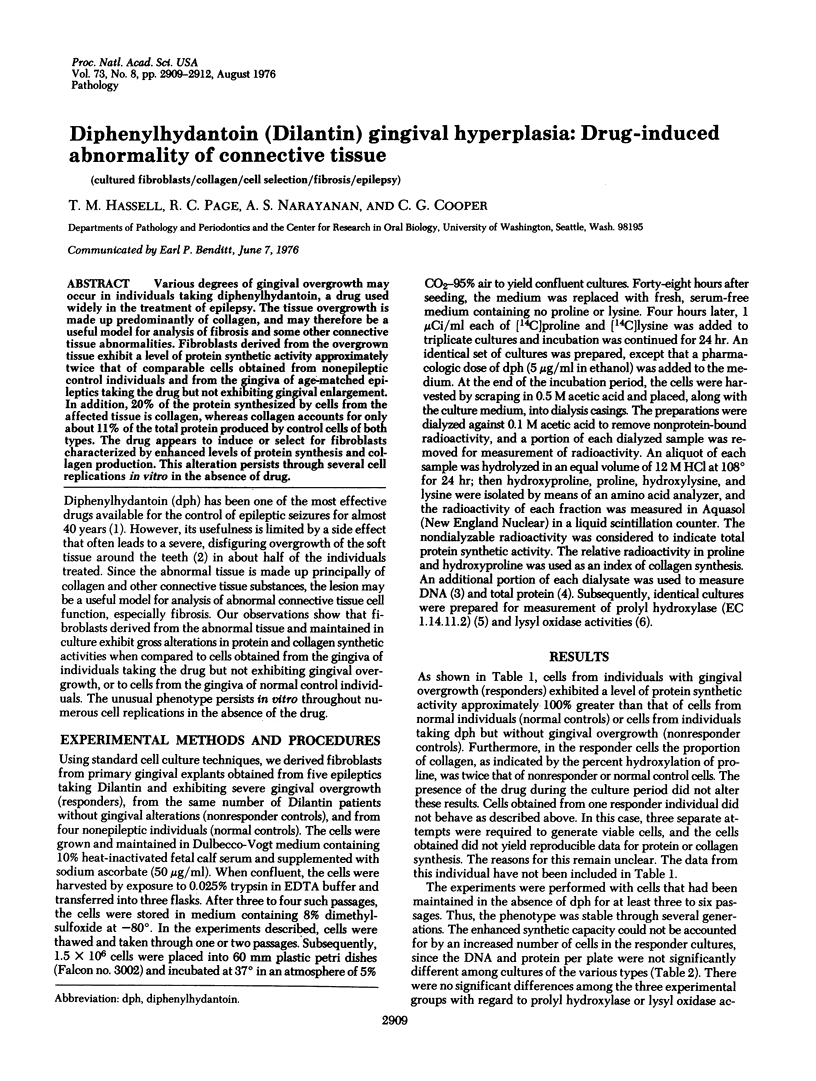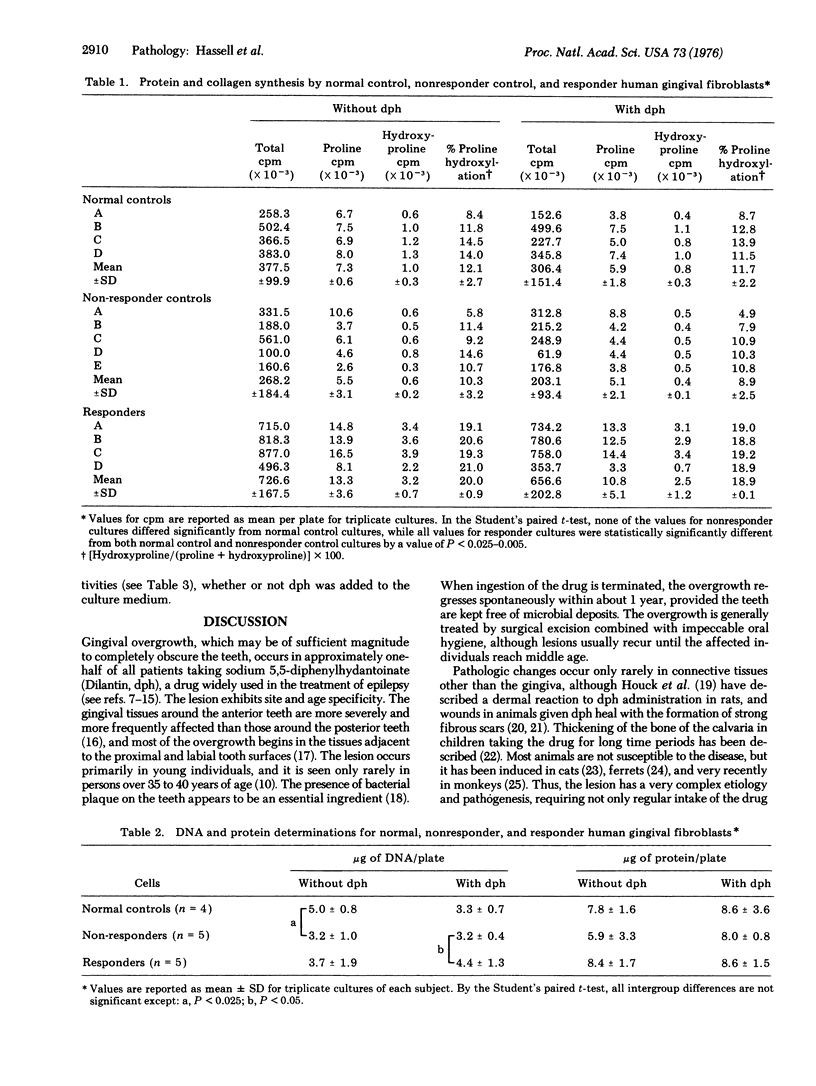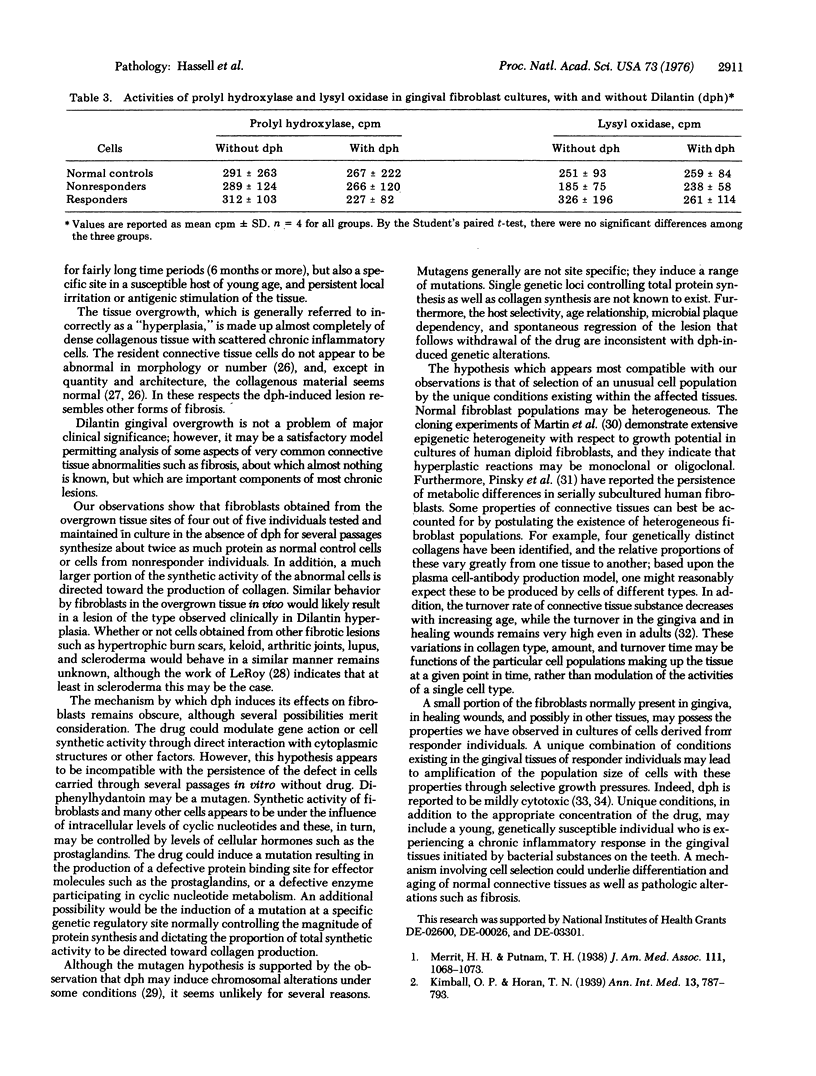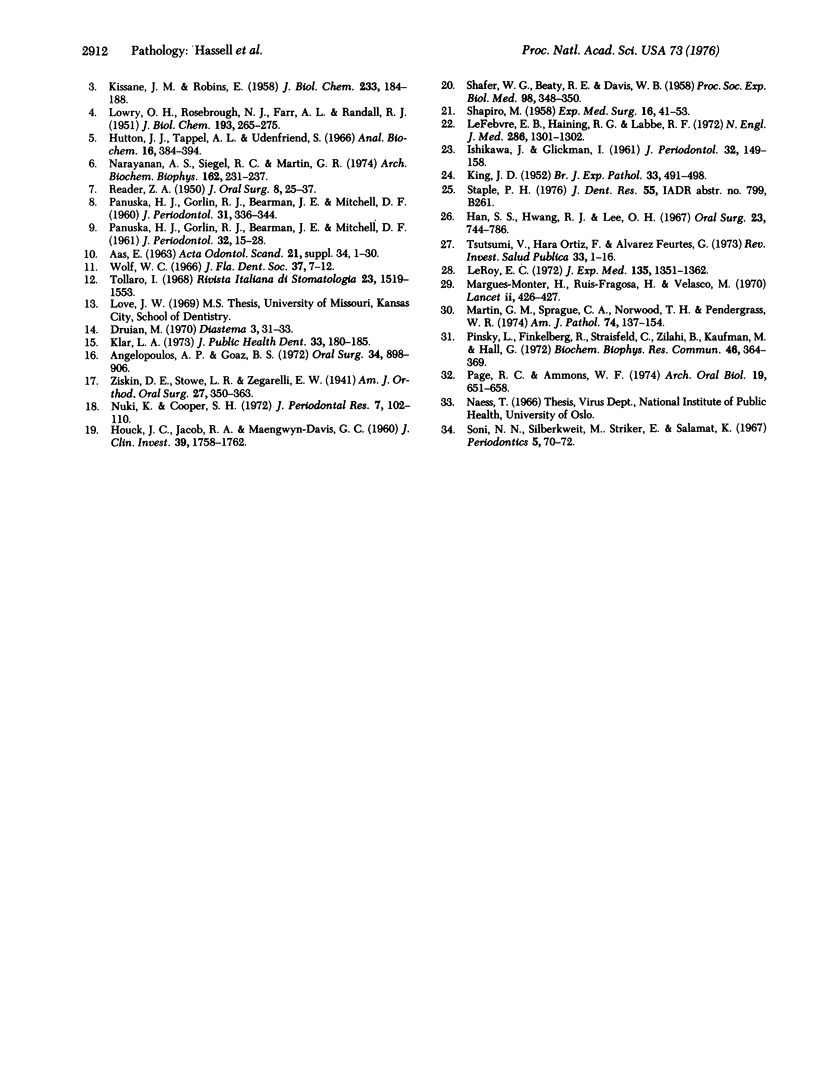Abstract
Various degrees of gingival overgrowth may occur in individuals taking diphenylhydantoin, a drug used widely in the treatment of epilepsy. The tissue overgrowth is made up predominantly of collagen, and may therefore be a useful model for analysis of fibrosis and some other connective tissue abnormalities. Fibroblasts derived from the overgrown tissue exhibit a level of protein synthetic activity approximately twice that of comparable cells obtained from nonepileptic control individuals and from the gingiva of age-matched epileptics taking the drug but not exhibiting gingival enlargement. In addition, 20% of the protein synthesized by cells from the affected tissue is collagen, whereas collagen accounts for only about 11% of the total protein produced by control cells of both types. The drug appears to induce or select for fibroblasts characterized by enhanced levels of protein synthesis and collagen production. This alteration persists through several cell replications in vitro in the absence of drug.
Full text
PDF



Selected References
These references are in PubMed. This may not be the complete list of references from this article.
- Angelopoulos A. P., Goaz P. W. Incidence of diphenylhydantoin gingival hyperplasia. Oral Surg Oral Med Oral Pathol. 1972 Dec;34(6):898–906. doi: 10.1016/0030-4220(72)90228-9. [DOI] [PubMed] [Google Scholar]
- Druian M. Effects on the oral mucosa of diphenylhydantoin sodium--a review of the literature and a clinical survey on 100 patients studied in Johannesburg. Diastema. 1970;3(1):31–passim. [PubMed] [Google Scholar]
- HOUCK J. C., JACOB R. A., MAENGWYN-DAVIES G. D. The effect of sodium dilantin administration upon the chemistry of the skin. J Clin Invest. 1960 Nov;39:1758–1762. doi: 10.1172/JCI104199. [DOI] [PMC free article] [PubMed] [Google Scholar]
- Han S. S., Hwang P. J., Lee O. H. A study of the histopathology of gingival hyperplasia in mental patients receiving sodium diphenylhydantoinate. Oral Surg Oral Med Oral Pathol. 1967 Jun;23(6):774–786. doi: 10.1016/0030-4220(67)90369-6. [DOI] [PubMed] [Google Scholar]
- KING J. D. Experimental production of gingival hyperplasia in ferrets given epanutin (sodium diphenyl hydantoinate). Br J Exp Pathol. 1952 Oct;33(5):491–498. [PMC free article] [PubMed] [Google Scholar]
- KISSANE J. M., ROBINS E. The fluorometric measurement of deoxyribonucleic acid in animal tissues with special reference to the central nervous system. J Biol Chem. 1958 Jul;233(1):184–188. [PubMed] [Google Scholar]
- Klar L. A. Gingival hyperplasia during dilantin-therapy; a survey of 312 patients. J Public Health Dent. 1973 Summer;33(3):180–185. doi: 10.1111/j.1752-7325.1973.tb00658.x. [DOI] [PubMed] [Google Scholar]
- LOWRY O. H., ROSEBROUGH N. J., FARR A. L., RANDALL R. J. Protein measurement with the Folin phenol reagent. J Biol Chem. 1951 Nov;193(1):265–275. [PubMed] [Google Scholar]
- Lefebvre E. B., Haining R. G., Labbé R. F. Coarse facies, calvarial thickening and hyperphosphatasia associated with long-term anticonvulsant therapy. N Engl J Med. 1972 Jun 15;286(24):1301–1302. doi: 10.1056/NEJM197206152862406. [DOI] [PubMed] [Google Scholar]
- Leroy E. C. Connective tissue synthesis by scleroderma skin fibroblasts in cell culture. J Exp Med. 1972 Jun 1;135(6):1351–1362. doi: 10.1084/jem.135.6.1351. [DOI] [PMC free article] [PubMed] [Google Scholar]
- Martin G. M., Sprague C. A., Norwood T. H., Pendergrass W. R. Clonal selection, attenuation and differentiation in an in vitro model of hyperplasia. Am J Pathol. 1974 Jan;74(1):137–154. [PMC free article] [PubMed] [Google Scholar]
- Márguez-Monter H., Ruiz-Fragoso E., Velasco M. Anticonvulsant drugs and chromosomes. Lancet. 1970 Aug 22;2(7669):426–427. doi: 10.1016/s0140-6736(70)90049-8. [DOI] [PubMed] [Google Scholar]
- Narayanan A. S., Siegel R. C., Martin G. R. Stability and purification of lysyl oxidase. Arch Biochem Biophys. 1974 May;162(1):231–237. doi: 10.1016/0003-9861(74)90123-4. [DOI] [PubMed] [Google Scholar]
- Nuki K., Cooper S. H. The role of inflammation in the pathogenesis of gingival enlargement during the administration of diphenylhydantoin sodium in cats. J Periodontal Res. 1972;7(2):102–110. doi: 10.1111/j.1600-0765.1972.tb00635.x. [DOI] [PubMed] [Google Scholar]
- Page R. C., Ammons W. F. Collagen turnover in the gingiva and other mature connective tissues of the marmoset Saguinus oedipus. Arch Oral Biol. 1974 Aug;19(8):651–658. doi: 10.1016/0003-9969(74)90133-2. [DOI] [PubMed] [Google Scholar]
- Pinsky L., Finkelberg R., Straisfeld C., Zilahi B., Kaufman M., Hall G. Testosterone metabolism by serially subcultured fibroblasts from genital and nongenital skin of individual human donors. Biochem Biophys Res Commun. 1972 Jan 31;46(2):364–369. doi: 10.1016/s0006-291x(72)80147-5. [DOI] [PubMed] [Google Scholar]
- READER Z. A. Gingival hyperplasia resulting from diphenylhydantoin sodium; a review of the literature. J Oral Surg (Chic) 1950 Jan;8(1):25-37, illust. [PubMed] [Google Scholar]
- SHAFER W. G., BEATTY R. E., DAVIS W. B. Effect of dilantin sodium on tensile strength of healing wounds. Proc Soc Exp Biol Med. 1958 Jun;98(2):348–350. doi: 10.3181/00379727-98-24040. [DOI] [PubMed] [Google Scholar]
- SHAPIRO M. Acceleration of gingival wound healing in non-epileptic patients receiving diphenylhydantoin sodium (dilantin, epanutin). Exp Med Surg. 1958;16(1):41–53. [PubMed] [Google Scholar]
- Soni N. N., Silberkweit M., Stricker E., Salamat K. Mitotic activity in human gingival epithelium associated with dilantin sodium therapy. Periodontics. 1967 Mar-Apr;5(2):70–72. [PubMed] [Google Scholar]
- Tollaro I. Contributo clinico-statistico sull'iperplasia gengivale da farmaci anticonvulsivanti. Riv Ital Stomatol. 1968 Oct;23(10):1519–1553. [PubMed] [Google Scholar]
- Tsutsumi V., Hara Ortíz F., Alvarez Fuertes G. La hiperplasia gingival en enfermos epilépticos tratados con difenilhidantoína. Estudio con el microscopio de luz y electrónico. Rev Invest Salud Publica. 1973 Jul-Dec;33(3-4):1–16. [PubMed] [Google Scholar]
- Wolf W. C. Incidence of Dilantin gingival hyperplasia. J Fla State Dent Soc. 1966 Nov;37(4):7–12. [PubMed] [Google Scholar]


